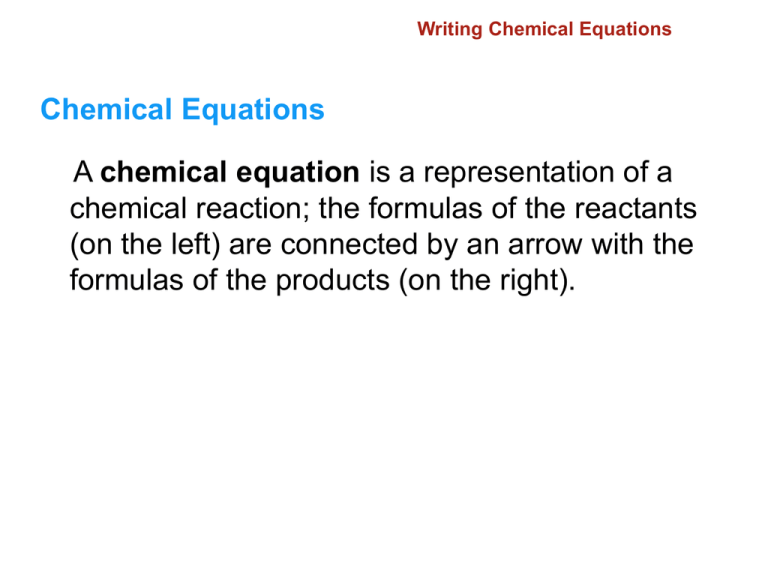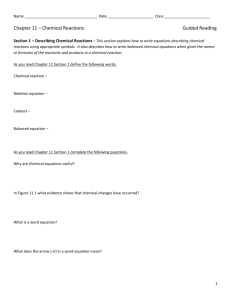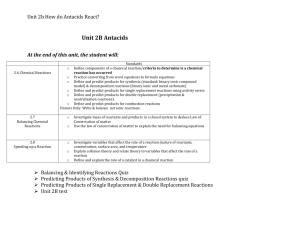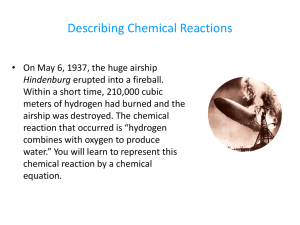c1l2ch11
advertisement

11.1 Writing Chemical Equations Chemical Equations A chemical equation is a representation of a chemical reaction; the formulas of the reactants (on the left) are connected by an arrow with the formulas of the products (on the right). 11.1 Writing Chemical Equations Word Equations To write a word equation, write the names of the reactants to the left of the arrow separated by plus signs; write the names of the products to the right of the arrow, also separated by plus signs. Reactant + Reactant Product + Product 11.1 Writing Chemical Equations Methane + Oxygen Carbon dioxide + Water 11.1 Writing Chemical Equations iron + oxygen iron(III) oxide 11.1 Writing Chemical Equations A skeleton equation shows the chemical formulae for the products and reactants, but not balanced. (More about balancing soon.) 11.1 Writing Chemical Equations Write the formulas of the reactants to the left of the yields sign (arrow) and the formulas of the products to the right. 11.1 Writing Chemical Equations A skeleton equation is a chemical equation that does not indicate the relative amounts of the reactants and products. Here is the equation for rusting: Fe + O2 Fe2O3 11.1 Writing Chemical Equations 11.1 Writing Chemical Equations A catalyst is a substance that speeds up the reaction but is not used up in the reaction. Without Catalyst With Catalyst for Conceptual Problem 11.1 11.1 Balancing Chemical Equations Balancing Chemical Equations What are the steps in writing a balanced chemical equation? A balanced equations follows conservation of matter. (Same amounts(moles, atoms) of reactant elements and same amounts of product elements.) 11.1 Balancing Chemical Equations To write a balanced chemical equation, first write the skeleton equation. Then use coefficients to balance the equation so that it obeys the law of conservation of mass. for Conceptual Problem 11.2 for Conceptual Problem 11.2 11.2 Classifying Reactions Six general types of reaction are combination, decomposition, single-replacement, double-replacement, combustion, and acid-base. 11.2 Classifying Reactions Combination Reactions A combination reaction is a chemical change in which two or more substances react to form a single new substance. for Conceptual Problem 11.4 11.2 Classifying Reactions Decomposition Reactions A decomposition reaction is a chemical change in which a single compound breaks down into two or more simpler products. for Conceptual Problem 11.5 Problem Solving 11.15 Solve Problem 15 with the help of an interactive guided tutorial. 11.2 Classifying Reactions Single-Replacement Reactions A single-replacement reaction is a chemical change in which one element replaces a second element in a compound. 11.2 Classifying Reactions The activity series of metals lists metals in order of decreasing reactivity. for Conceptual Problem 11.6 11.2 Classifying Reactions Double-Replacement Reactions A double-replacement reaction is a chemical change involving an exchange of positive ions between two compounds. for Conceptual Problem 11.7 11.2 Classifying Reactions Combustion Reactions A combustion reaction is a chemical change in which an element or a compound reacts with oxygen, often producing energy in the form of heat and light. for Conceptual Problem 11.8 11.2 Predicting the Products of a Chemical Reaction Predicting the Products of a Chemical Reaction How can you predict the products of the five general types of reactions? 11.2 Predicting the Products of a Chemical Reaction The number of elements and/or compounds reacting is a good indicator of possible reaction type and thus possible products. 11.2 Predicting the Products of a Chemical Reaction 11.2 Predicting the Products of a Chemical Reaction 11.2 Predicting the Products of a Chemical Reaction 11.2 Predicting the Products of a Chemical Reaction 11.2 Predicting the Products of a Chemical Reaction 11.2 Section Quiz. 1. What type of reaction is described by the following equation? 6Li + N2 2Li3N combination reaction decomposition reaction single-replacement reaction combustion reaction 11.2 Section Quiz. 2. Balance the following equation and indicate whether it represents a combustion, combination, or decomposition reaction. H2SO4 H2O2 + SO2 H2SO4 H2O2 + SO2, combination reaction H2SO4 H2O2 + SO2, decomposition reaction H2SO4 2H2O2 + SO2, combination reaction H2SO4 2H2O2 + SO2, decomposition reaction 11.2 Section Quiz. 3. Predict the missing product in the following unbalanced equation. Pb(NO3)2 + KOH KNO3 + ____________ PbOH2 Pb(OH)4 Pb(OH)2 PbOH 11.3 Net Ionic Equations A complete ionic equation is an equation that shows dissolved ionic compounds as dissociated free ions. 11.3 An Net Ionic Equations ion that appears on both sides of an equation and is not directly involved in the reaction is called a spectator ion. The net ionic equation is an equation for a reaction in solution that shows only those particles that are directly involved in the chemical change. 11.3 Net Ionic Equations A net ionic equation shows only those particles involved in the reaction and is balanced with respect to both mass and charge. 11.3 Net Ionic Equations Sodium ions and nitrate ions are not changed during the chemical reaction of silver nitrate and sodium chloride so the net ionic equation is for Conceptual Problem 11.9 Problem Solving 11.28 Solve Problem 28 with the help of an interactive guided tutorial. 11.3 Predicting the Formation of a Precipitate Predicting the Formation of a Precipitate How can you predict the formation of a precipitate in a double-replacement reaction? 11.3 Predicting the Formation of a Precipitate You can predict the formation of a precipitate by using the general rules for solubility of ionic compounds. 11.3 Predicting the Formation of a Precipitate 11.3 Predicting the Formation of a Precipitate Will a precipitate form when a sodium carbonate solution is mixed with a barium nitrate solution? 11.3 Predicting the Formation of a Precipitate Sodium nitrate is soluble but barium carbonate is insoluble. The net ionic equation is




